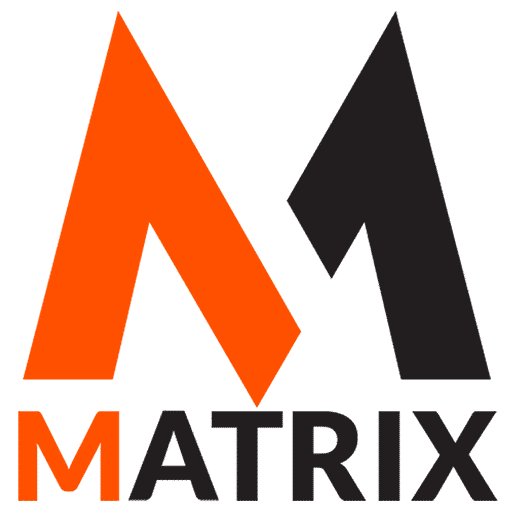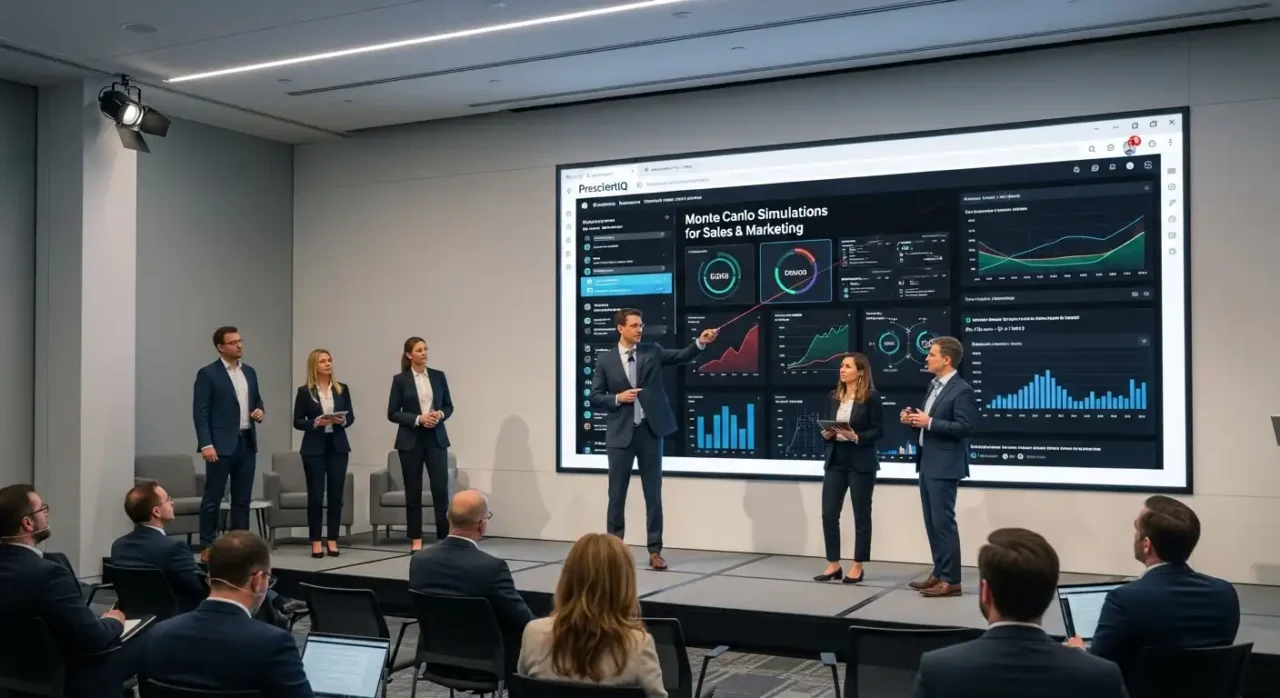How PrescientIQ and Monte Carlo Simulations are Revolutionizing Sales & Marketing
Learn Decoding the Crystal Ball: How PrescientIQ and Monte Carlo Simulations are Revolutionizing Sales & Marketing.
Close your eyes: you’re a seasoned poker player, a CMO at the high-stakes table of the market. You’ve got your “hand” – your current marketing strategy, budget, and campaign ideas. Your competitors are laying their bets, and the “flop” (market conditions, consumer trends, competitor actions) is about to reveal itself.
In the old days, you’d make your move based on intuition, a few past games, and perhaps a gut feeling about your opponents. You’d play your hand, hoping for the best, and once the cards were out, you’d know if you won or lost.
Now, imagine if you had a secret weapon: a “card simulator.” Before you even place your first bet, this simulator lets you play out the entire poker game thousands, even millions, of times, with slightly different “flops” and competitor reactions.
It shows you every possible outcome: how likely you are to win with your current hand, what happens if you bluff, if you raise, if you fold. It even shows you the probability of each outcome.
That “card simulator” is a Monte Carlo simulation for sales and marketing. Instead of just guessing or relying on a single forecast, it allows you to:
- See the full spectrum of possibilities: Not just one predicted outcome, but a range of potential scenarios, from best-case to worst-case, and how likely each is.
- Stress-test your strategies: What happens to your campaign ROI if a new competitor enters the market? What if your ad costs increase by 10%?
- Identify optimal moves: By running countless “what-if” scenarios, you can pinpoint the strategies that offer the highest probability of success with the least risk.
- Quantify uncertainty: Instead of vague “it might happen,” you get precise probabilities: “there’s a 70% chance of achieving X revenue, but a 15% chance of falling below Y.”
Just like a poker player who uses a simulator can make more confident, data-driven decisions at the table, a CMO armed with Monte Carlo simulations can navigate the volatile market with unparalleled foresight, turning uncertainty into a strategic advantage and consistently playing a winning hand.
You’re not just hoping to win; you’re playing the odds with precision.
I. Introduction: Beyond Guesswork – Predicting Your Path to Profit
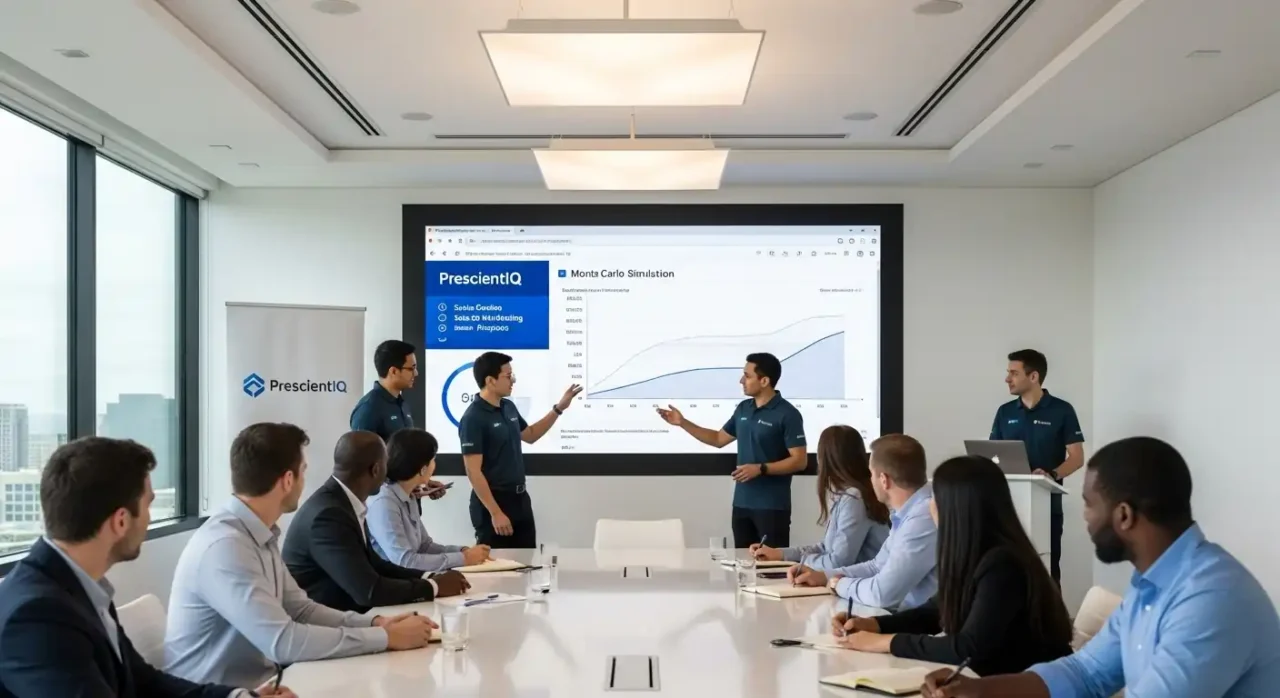
Remember the Mad Men era of marketing, when gut instinct and a persuasive pitch were the weapons of choice? A time when a catchy jingle could launch a brand, and a well-placed ad could sway consumer behavior.
We’ve come a long way since then. In today’s data-drenched world, flying blind is not just irresponsible; it’s a recipe for obsolescence. Throwing spaghetti at the wall to see what sticks? Those days are going extinct faster than you can say “conversion rate optimization.”
Why?
Because a powerful duo has arrived, poised to reshape the very fabric of sales and marketing: AI-driven “intelligent foresight” platforms like PrescientIQ and the statistical wizardry of Monte Carlo simulations.
We’re not just talking about incremental improvements here. We’re talking about a paradigm shift – a move from reactive guessing to proactive, predictable growth.
Imagine being able to peek into the future, to understand the likely consequences of your strategic decisions before you commit valuable resources.
This is the promise of these advanced tools, and it’s a promise that’s rapidly becoming reality. Get ready to understand your future, before it even happens.
The stakes are high, and the growth potential is astronomical. Consider this: The AI for sales and marketing market is projected to skyrocket from USD 57.99 billion in 2025 to USD 240.58 billion by 2030, a whopping CAGR of 32.9%.
That’s not just a blip on the radar; it’s a tidal wave. And it signals a fundamental change in how businesses approach the challenge of acquiring and retaining customers.
But the story doesn’t end with market projections. The real proof is in the pudding. Companies that are already investing in AI are seeing tangible results, a revenue uplift of 3% to 15% and a sales ROI uplift of 10% to 20%.
These are not insignificant gains; they’re the kind of numbers that can transform a company’s trajectory. The question, then, isn’t whether to embrace these technologies, but how to do so effectively.
AI has become operational.
II. The Problem: Drowning in Data, Starved for Insight
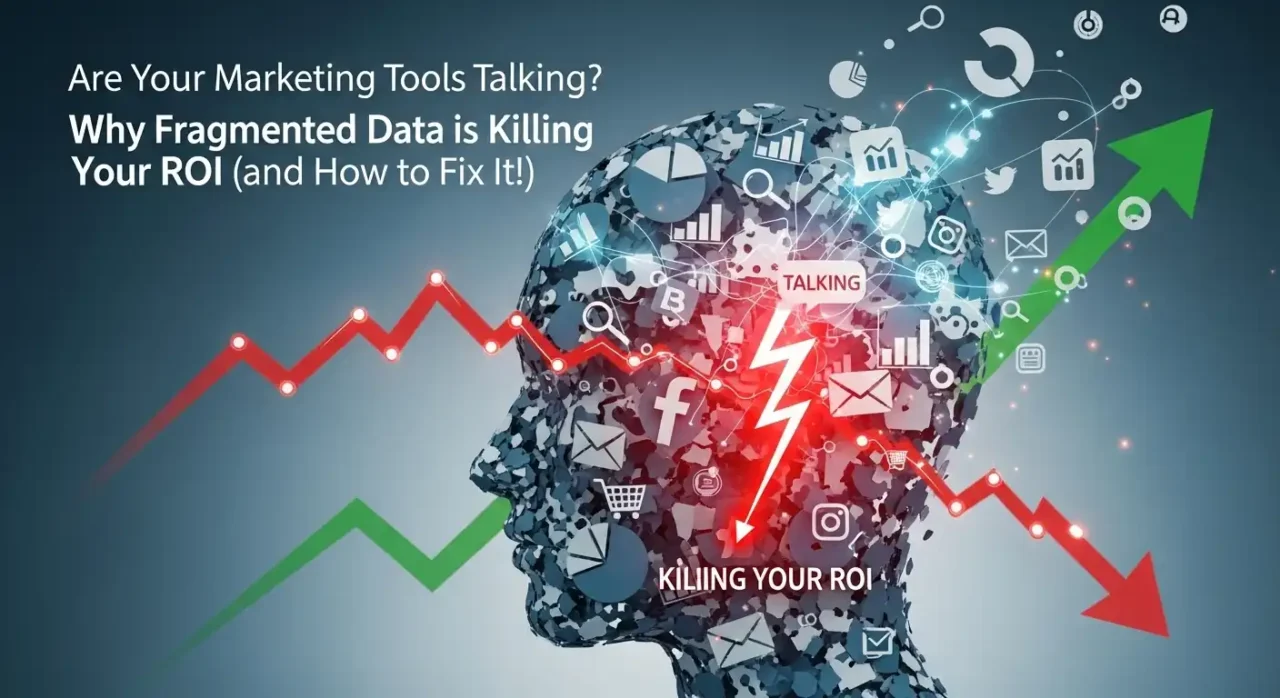
Today’s B2B leaders find themselves in a paradoxical situation. They are drowning in data, awash in metrics, and yet, often starved for genuine insight.
The information age promised clarity, but it has often delivered only confusion. What are the key challenges that are holding businesses back?
Firstly, we have the curse of fragmented tool stacks. In the quest for the perfect solution, many companies have assembled a patchwork of disconnected platforms, each vying for attention, each generating its own silo of data.
The result is a chaotic ecosystem where information is scattered, insights are buried, and valuable opportunities are missed.
Then there’s the relentless grind of manual mayhem.
Despite the proliferation of automation tools, marketing and sales teams still spend countless hours on repetitive tasks, ranging from data entry to report generation. This not only saps productivity but also stifles creativity and strategic thinking.
Imagine the possibilities if these teams could be freed from the mundane to focus on higher-level activities that truly move the needle.
Perhaps the most insidious challenge is the rise of opaque AI. Many AI tools operate as “black boxes,” spitting out recommendations without explaining why. This lack of transparency breeds mistrust, making it difficult for leaders to embrace the technology fully. After all, how can you confidently implement a strategy when you don’t understand the reasoning behind it?
Finally, and perhaps most significantly, businesses grapple with uncertainty & risk. The modern marketplace is characterized by volatility, disruption, and unforeseen events.
Traditional forecasting methods struggle to keep pace, leaving businesses vulnerable to unexpected shifts and market turbulence. In this environment, the ability to anticipate and plan for multiple future scenarios is not just an advantage; it’s a necessity.
Faced with these challenges, businesses need to find a way to:
- Predict conversion outcomes accurately, moving beyond guesswork and intuition.
- Optimize ad spend and budget allocation in real-time, maximizing ROI and minimizing waste.
- Automate repetitive marketing and sales tasks, freeing up valuable time and resources.
- Gain clear, actionable insights into campaign performance and customer behavior, understanding what works and what doesn’t.
- Reduce sales cycles and boost pipeline growth, accelerating revenue generation and market penetration.
- Mitigate risks and plan for multiple future scenarios, ensuring resilience in the face of uncertainty.
These are the critical needs that must be addressed if businesses are to thrive in the modern landscape.
PrescientIQ & Monte Carlo: Explained
What is PrescientIQ?
PrescientIQ is an advanced analytics platform designed to provide foresight and intelligent insights, often in complex business environments. It aims to make data-driven predictions and recommendations to optimize decision-making processes.
- Focuses on predictive modeling and intelligence.
- Utilizes various analytical techniques to uncover hidden patterns.
- Aids in strategic planning and operational efficiency.
What is the Monte Carlo Simulation?
The Monte Carlo simulation is a computer-based mathematical technique that allows people to account for risk in quantitative analysis and decision making. It repeatedly samples random inputs to model the probability of different outcomes in a process that contains inherent uncertainty.
- Models outcomes of complex systems.
- Uses random sampling to simulate many possible scenarios.
- Provides a range of possible results and their probabilities.
How Do They Connect?
PrescientIQ often incorporates sophisticated analytical methods, and the Monte Carlo simulation is a powerful tool frequently utilized within such platforms. When integrated, Monte Carlo simulations can enhance PrescientIQ’s predictive capabilities by rigorously testing various scenarios under uncertainty.
- Monte Carlo helps PrescientIQ quantify risk in its predictions.
- It allows PrescientIQ to show a spectrum of potential futures, not just one.
- Strengthens the reliability and depth of PrescientIQ’s insights.
Benefits of Their Synergy
The combination of PrescientIQ’s intelligence framework and Monte Carlo’s robust simulation offers unparalleled benefits for organizations aiming to navigate uncertainty, optimize resource allocation, and make more resilient strategic choices.
- Improved accuracy in forecasting.
- Better understanding of potential risks and opportunities.
- Enhanced decision-making under uncertainty.
- More robust strategic planning.
III. What’s the Big Deal? PrescientIQ & Monte Carlo, Explained
So, how can businesses overcome these challenges and unlock their full potential?
The answer lies in embracing advanced tools like PrescientIQ and the power of Monte Carlo simulations. Let’s delve into what makes these technologies so transformative.
PrescientIQ: Your AI Growth Suite (The Brains)
Developed by MatrixLabX, an innovative offspring of Matrix Marketing Group, PrescientIQ is an AI-driven platform designed for autonomous sales and marketing.
It’s more than just a collection of features; it’s an intelligent engine that unifies predictive insights, workflow automation, and campaign orchestration. Launched on October 8, 2025, PrescientIQ represents a bold step forward in the evolution of marketing technology.
Why is it so important? Because it moves you beyond the limitations of basic reporting to real-time, adaptive optimization. It delivers “glass-box insights” that reveal why decisions are made, eliminating the “black box” mystery that plagues so many AI solutions.
This transparency is crucial for building trust and fostering a deeper understanding of the underlying dynamics driving campaign performance. But it’s the simplicity and power for prescient operations, evolving into a cognitive operating system
PrescientIQ boasts a powerful arsenal of key features, including:
- Predictive Intelligence & Lead Scoring: This feature is like having a crystal ball that reveals your golden leads before you even know they exist. By analyzing vast amounts of data, PrescientIQ can identify prospects with the highest likelihood of conversion, allowing you to focus your efforts where they will have the greatest impact.
- Orchestration & Automation: Imagine a self-driving car for your marketing campaigns. That’s the power of PrescientIQ’s orchestration and automation capabilities. The platform dynamically adjusts campaigns on the fly, optimizing performance in real-time and ensuring that your message reaches the right audience at the right time.
- Unified Data & Semantic CDP: Data silos are the bane of modern marketing. PrescientIQ solves this problem by gathering all your data into one smart brain, creating a comprehensive view of the customer journey across all channels. This unified data foundation enables more accurate insights and more effective targeting.
- Glass-Box Insights: This is where PrescientIQ truly shines. Unlike “black box” AI solutions, PrescientIQ shows you the AI’s homework, explaining its decisions and providing “what-if” scenarios to help you understand the potential consequences of different actions.
Monte Carlo Simulations: The Ultimate “What If” Machine (The Analyst)
While PrescientIQ provides the intelligent engine for driving your sales and marketing efforts, Monte Carlo simulations offer a complementary tool for navigating uncertainty and mitigating risk.
What are Monte Carlo simulations? They are a powerful computational technique that runs thousands, even millions, of random scenarios to model uncertain events.
Instead of relying on a single point estimate, you get a whole range of possible outcomes and their probabilities. This allows you to see the spectrum of possibilities and make more informed decisions.
Why are they so important? By quantifying uncertainty and risk, they help you create robust plans by revealing a spectrum of possibilities.
They are essential for forecasting, pricing, and risk assessment in a volatile market. Imagine being able to stress-test your marketing budget under different economic conditions, or to assess the potential impact of a new competitor entering the market. This is the power of Monte Carlo simulations.
The Dream Team:
While the research doesn’t explicitly state that PrescientIQ uses Monte Carlo simulations, the platform’s predictive models and “what-if” scenarios are perfectly complemented by Monte Carlo’s probabilistic approach.
Imagine an AI that not only predicts what will happen but also how likely it is to happen under various conditions!
This is the future of sales and marketing: a fusion of artificial intelligence and statistical modeling that empowers businesses to make data-driven decisions with confidence.
IV. Industries Feeling the Foresight
PrescientIQ is not a one-size-fits-all solution. It’s designed for B2B sales and marketing operations, with industry-tailored bundles ready for rapid deployment.
This enables businesses to quickly leverage the platform’s capabilities, eliminating the need for months of customization to meet their specific needs.
Some of the industries that are particularly well-suited for PrescientIQ include:
- Technology & SaaS: These innovative companies are constantly seeking new ways to gain a competitive edge. PrescientIQ’s predictive campaign orchestration and customer intent modeling capabilities can help them optimize their marketing spend and drive faster growth.
- Manufacturing & Industrial: These businesses often face complex sales cycles and fluctuating market conditions. PrescientIQ’s account-based forecasting and margin-aware optimization features can help them improve their profitability and reduce their risk.
- Professional Services: Building thought leadership and generating qualified leads are critical for success in the professional services industry. PrescientIQ’s authority content pipelines and localized ROI intelligence can help firms attract new clients and build their brand.
However, the potential applications of PrescientIQ extend far beyond these core industries.
E-commerce, Financial Services, Education, Healthcare, MedTech, Construction, Hospitality – any sector needing precise go-to-market strategies can benefit from the platform’s advanced capabilities.
V. George Schildge’s Vision: The Architect of Autonomous Growth
To truly understand the potential of PrescientIQ, it’s essential to consider the vision of its architect, George Schildge, CEO of MatrixLabX. Schildge is not just a technologist; he’s a pioneer, a leading mind in AI marketing who sees AI as a transformative, not just incremental, force.
He believes that AI is creating a new marketing paradigm, moving beyond simple automation to predictive, adaptive, and autonomous solutions.
Schildge emphasizes that AI enhances human creativity, freeing marketers from high-level strategy by handling repetitive tasks. He advocates for “glass-box” transparency, allowing businesses to understand the “why” behind AI decisions and build proprietary models.
This focus on transparency is crucial for building trust and ensuring that AI is used ethically and effectively.
His core message? Don’t just automate chaos; leverage AI for genuine, autonomous growth with clear, measurable outcomes.
This is not about replacing human marketers with robots; it’s about empowering them with the tools they need to be more effective, more creative, and more strategic.
VI. The AI Marketing Arena: Who’s Playing and How Matrix Marketing Group Stands Out
The AI marketing arena is becoming increasingly crowded, with a diverse range of players vying for attention.
To understand how Matrix Marketing Group stands out, it’s helpful to consider the different competitor archetypes:
- Traditional Digital Marketing Agencies: These agencies are often AI-curious but lack proprietary AI platforms, relying on third-party tools and human-intensive processes. They may offer some AI-powered services, but they lack the deep integration and customization that Matrix Marketing Group can provide.
- Generic AI Automation Platforms: These platforms offer automation features but lack the deep predictive intelligence or “glass-box” transparency of PrescientIQ. They can help businesses to streamline their workflows, but they don’t provide the strategic insights needed to drive significant growth.
- Standalone Predictive Analytics Tools: These tools excel at generating insights but often lack integration with execution, necessitating manual intervention to act on predictions. They can help businesses to understand their customers and their markets, but they don’t provide the automation needed to translate those insights into action.
- “Black-Box” AI Solutions: These solutions deliver results without explaining the underlying logic, which can foster mistrust and limit strategic learning. They may be effective in the short term, but they don’t empower businesses to understand and control their own marketing destiny.
- Niche AI Content Generators: These tools focus on one aspect of marketing (e.g., text, images) but don’t offer a unified, autonomous growth suite. They can help businesses to create content more efficiently, but they don’t provide the comprehensive solution needed to drive sustainable growth.
- Simplicity, accuracy, and security: PrescienctIQ enhances security for application development by providing a secure platform with built-in features like data encryption and network controls to protect the AI models and data themselves. Furthermore, its powerful machine learning capabilities are leveraged by security tools to monitor applications, detect threats, and even automate the generation of code to fix vulnerabilities. This enables organizations to build secure AI-powered applications and leverage AI to enhance the security posture of their entire application landscape.
Matrix Marketing Group, powered by MatrixLabX and PrescientIQ, carves its own path. They’re not just an agency; they’re an AI-first operating system for marketing. What sets them apart?
- Performance-Based Pricing: This is a game-changer. Matrix Marketing Group aligns its success with yours, eliminating traditional retainers and charging based on measurable results (CPL, CPA, Revenue-Share). You only pay for what works. This demonstrates a level of confidence and accountability that is rare in the industry.
- Proprietary AI (PrescientIQ & NeuralEdge™): They don’t just use AI; they build it. This means deeper customization, better integration, and a “glass box” approach that gives you full visibility into the AI’s reasoning.
- LLM Optimization: Their advanced AI, including LLM optimization, ensures content is not just generated, but strategically positioned for search and audience resonance, maximizing impact.
VII. MatrixLabX & Matrix Marketing Group in Action: Applications that Deliver
MatrixLabX and Matrix Marketing Group offer a range of applications that demonstrate the power of AI-driven marketing:
- PrescientIQ’s Autonomous Sales & Marketing Platform: The flagship AI Growth Suite from MatrixLabX, unifying predictive insights, workflow automation, and campaign orchestration. It literally “thinks ahead” for your go-to-market strategy.
- Funnel Performance Simulator (matrixmarketinggroup.com): A tool that allows you to model multi-step scenarios, visualize how different strategies impact conversion rates, and forecast revenue projections over time, powered by AI.
- Predictive Targeting and Segmentation Model (matrixmarketinggroup.com): Leverages AI to identify high-value prospects, segment audiences with precision, and enable hyper-personalized campaigns, ensuring your message reaches the right person at the right time.
VIII. The “Black Box” Controversy: Why Transparency is Key
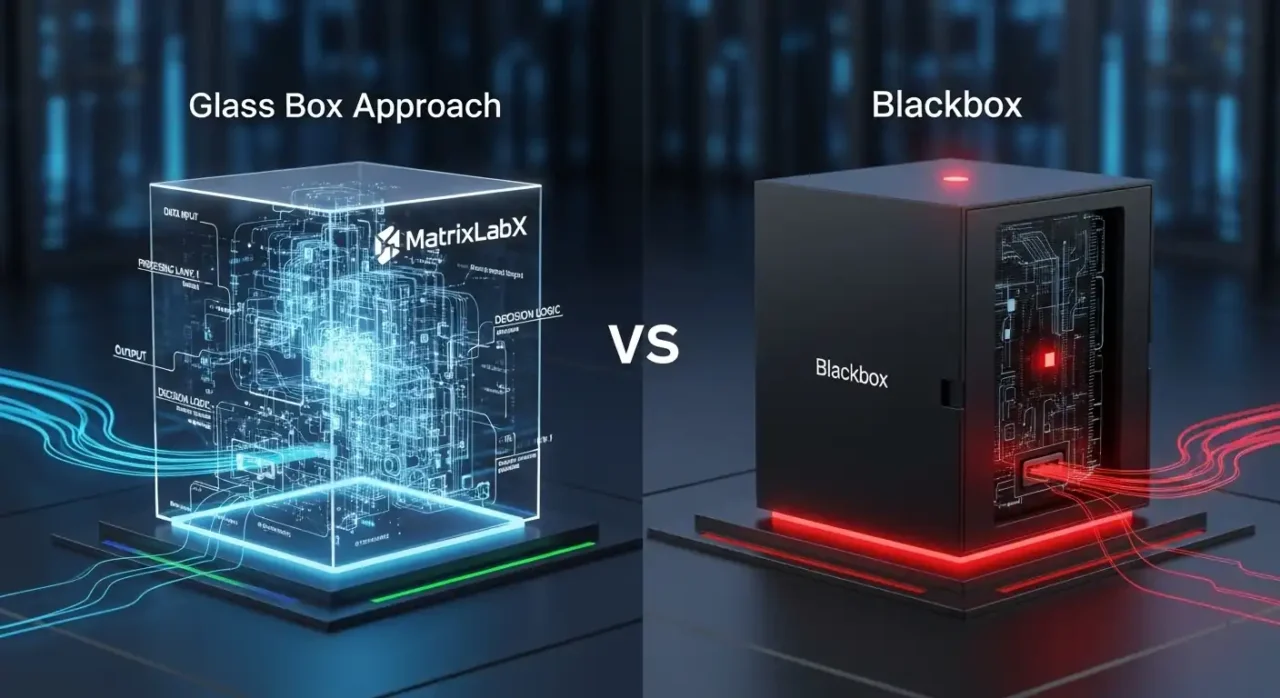
While AI offers incredible power, a key point of contention (and what PrescientIQ addresses) is the “black-box” problem. Many AI systems make decisions without clearly showing how they arrived at them. This lack of transparency can lead to:
- Mistrust: Business leaders are hesitant to commit to strategies they don’t understand fully.
- Bias: Hidden biases in AI models can perpetuate unfair or ineffective outcomes.
- Limited Learning: Without understanding the “why,” businesses can’t truly learn or refine their own strategies.
PrescientIQ’s “Glass-Box Insights” directly confronts this by revealing root causes, feature importance, and “what-if” scenarios, ensuring explainable AI and fostering confidence.
IX. Real-World Wins: Case Studies in AI-Driven Marketing
The true measure of any technology is its ability to deliver real-world results. Here are a couple of case studies that demonstrate the impact of PrescientIQ:
Case Study 1: B2B SaaS Company Elevates Pipeline Growth
- Challenge: A rapidly growing SaaS company struggled with inconsistent lead quality and long sales cycles, leading to unpredictable pipeline growth. Their manual lead scoring was inefficient.
- Matrix Marketing Group / PrescientIQ Solution: Implemented PrescientIQ’s Predictive Intelligence & Lead Scoring, combining CRM and behavioral data. The platform autonomously prioritized high-impact leads and optimized budget allocation across digital campaigns using scenario planning.
- Results: Within six months, the company experienced a 40% increase in marketing-sourced pipeline and 25% faster lead-to-opportunity conversions, significantly shortening their sales cycle and improving resource allocation agility.
Case Study 2: Manufacturing Firm Streamlines Campaign Deployment
- Challenge: A large manufacturing client faced lengthy campaign deployment times due to fragmented data and manual orchestration across multiple channels, hindering their ability to respond quickly to market shifts.
- Matrix Marketing Group / PrescientIQ Solution: Deployed PrescientIQ’s Orchestration & Automation features, unifying their advertising, content, and email campaigns. The system dynamically adjusted creatives and scheduling based on real-time market signals.
- Results: The manufacturing firm achieved a 55% reduction in campaign deployment times, allowing for more agile marketing. They also saw a 35% improvement in overall campaign ROI due to optimized budget reallocation, directly impacting their bottom line.
X. Why Matrix Marketing Group is the AI Performance Powerhouse
Matrix Marketing Group isn’t just an agency that uses AI; they are an AI-first operating system. They offer:
- Performance-Based Pricing: They put their money where their mouth is. They’re confident in their results because their proprietary MatrixLabX AI, including PrescientIQ, delivers. They only succeed when you do.
- “Glass-Box” Transparency: No black boxes here. Their clients gain full visibility into the AI’s logic, fostering trust, continuous learning, and the strategic development of their own “data moat.”
- LLM Optimization Prowess: Their deep expertise in LLM optimization ensures that content generated and deployed is perfectly tailored, highly effective, and consistently ranked for maximum impact in today’s evolving AI Search Era.
- Beyond Automation to Autonomy: They offer truly autonomous growth engines, reducing manual toil and freeing your team to focus on innovation.
XI. The Horizon: What’s Next for AI and Foresight in Marketing?
The field of AI and foresight in marketing is evolving at an exponential pace. Here are some of the key trends to watch:
- Agentic AI Ascendant: Expect more “digital teammates” that don’t just predict, but proactively act, triggering campaigns and adjusting strategies autonomously.
- Real-Time Monte Carlo: Faster computational power will enable continuous, real-time simulations for instantaneous risk assessment and dynamic decision-making.
- Hyper-Personalization at Scale: AI will anticipate customer needs with uncanny accuracy, driving one-to-one experiences across every touchpoint.
- Explainable AI (XAI) as Standard: Transparency will be a requirement, not a luxury, for all AI solutions, fostering trust and ethical deployment.
- Synthetic Data Revolution: AI will create realistic synthetic data for robust testing, especially where real data is scarce or sensitive.
- No-Code/Low-Code AI: Democratizing AI access, allowing more marketers to build and deploy sophisticated models without deep technical expertise.
XII. Conclusion: The Future is Here, and It’s Predictable
The convergence of AI and statistical modeling is reshaping the landscape of sales and marketing. Here are some key takeaways:
- Learning 1: Predict, Don’t React: The era of reactive marketing is over. AI and Monte Carlo simulations empower businesses to anticipate the future and act with foresight.
- Learning 2: Transparency Builds Trust: “Glass-box” AI like PrescientIQ is crucial for understanding why decisions are made, fostering confidence and strategic alignment.
- Learning 3: Autonomy Fuels Growth: By embracing autonomous sales and marketing, businesses can eliminate manual workflows, optimize resource allocation, and achieve unprecedented scalability.
- Learning 4: Performance-Based is the New Standard: Agencies that tie their success directly to client results, powered by proprietary AI, are leading the charge in accountability and ROI.
The convergence of AI and stochastic simulations isn’t just a trend; it’s a fundamental shift.
Companies that embrace these technologies, particularly with transparent, performance-driven partners like Matrix Marketing Group, are not just adapting to the future – they are actively building it.
The crystal ball is no longer a myth; it’s a reality, and it’s within reach for those who are willing to embrace the power of AI and foresight.
AI Playbook Selector by Industry
Find Your AI Marketing Playbook
Pick your industry → go straight to your tailored AI Playbook.
